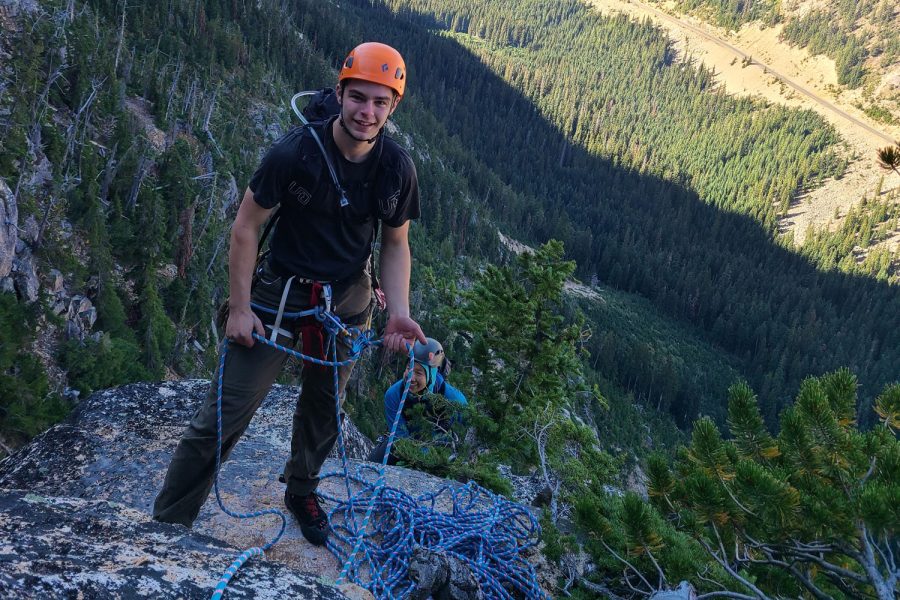Rescue Ranger
David Baylor volunteers with Search and Rescue
Photo: Jeff Baylor
David Baylor is pictured climbing Spontaneity Aerate in the Washington pass area near Mazama.
While most seniors spend their free time playing sports or socializing with friends, senior David Baylor spends his weekends volunteering for King County Search and Rescue Association.
“Search and Rescue is the group of people who go out and help anybody who needs help or is in distress,” Baylor said. “It is the outside of the range that the fire department can get to. If somebody gets in trouble, they call 911 or they have an inReach or SOS beacon and that will go to us and we can help.”
Baylor started off as a Boy Scout and then moved into Search and Rescue when his friend brought up the idea. He began his training early in the fall of 2019 and started responding to calls in the spring of 2020. Search and Rescue is a 100% volunteer and donation-funded organization and they work under the Sheriff’s Department as they help direct the calls. After six months of training, Baylor began responding to calls.
“So there is a bunch of training from medical aspects,” Baylor said. “Then, there are the actual search and rescue parts: helping people, learning the navigations, and having the survival skills to be out there and not need rescuing yourself while you are on the mission.”
His volunteering includes a variety of medical calls. This includes injured hikers, people who have gotten lost and people who have not come back in time. The methods of rescue differ by the mission, but they tend to use one core method.
“The bread and butter of what we do is called a pack out. If someone is unable to walk we put them in what is called a litter: a stretcher with a big tire on the bottom. That is a skill we spend a lot of time on,” Baylor said.
The typical mission begins with a text notifying the team of the situation. After this, the team meets at the trail head and receives a briefing about the mission. Depending on the severity of the injuries and situation, there are different search strategies the team can take.
“If it is somebody who is kind of injured and we have a good sense of where they are, we will start sending teams up pretty quickly with the medical supplies,” Baylor said. “If it is more of a search and we do not know what is going on, we will spend the time to assign assignments and then spread out and do a full search.”
Once the team has figured out the situation, their next move is to figure out the safest way to evacuate the individual.
“The evacuation looks different for different scenarios. If we were on a trail and it is a decent trail, we will usually go about a mile an hour. Packing someone out can get long, but if you get a good team then you switch out,” Baylor said. “We also work with the Sheriff’s Department which has a helicopter, so if it’s a more difficult pack out we will call a helicopter.”
The team changes depending on the mission, but there are around 30-50 volunteers who are active. Baylor has done the training to be a team leader so that he can lead other small groups in the field.
“When we first get to the scene, we will be dealing with any medical situation we have and then also dealing with the other people around. A part of the team leader training that I have done is to kind of organize the scene. Having somebody do the medical work and having someone figure out how to get us out.”
The whole process consists of a variety of challenges.
“I think just generally being presented with a challenging situation, we are helping somebody who is in a difficult spot or in a difficult terrain,” Baylor said.
Though volunteering for Search and Rescue means that missions may come up at an inconvenient time, Baylor has made it a priority as he values helping people.
“That is something that I have really enjoyed and as I am going through the college process and figuring out what I want to do, it has played a really big role in that as well,” Baylor said.
Helping people out of difficult spots and working as a team is extremely rewarding.
“Seeing the process of getting them out of the situation, getting them to safety and then reuniting them with their family is really empowering,” Baylor said.


Annabel Wickham is one of the web editors-in-chief of UPrepmedia.com and she has been on staff for three years. Her favorite stories to write are student...


